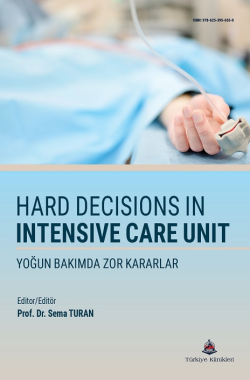ARTERIAL CATHETERIZATION
Abdullah Kahraman
Ankara Etlik City Hospital, Department of Anesthesiology and Reanimation, Ankara, Türkiye
Kahraman A. Arterial Catheterization. In: Turan S, editor. Hard Decisions in Intensive Care Unit. 1st ed. Ankara: Türkiye Klinikleri; 2025. p.305-312.
ABSTRACT
Arterial catheterization is a frequently performed procedure in operating rooms, intensive care units, and emergency departments. By inserting a cannula into an artery, it allows for continuous hemodynamic monitoring and ongoing sample collection for laboratory analysis. Furthermore, advancements in hemodynamic monitoring provide opportunities for the evaluation of cardiac functions in intensive care settings. The procedure can be performed using various arteries. Although the radial artery is most commonly preferred, the brachial, ulnar, axillary, femoral, dorsalis pedis, and posterior tibial arteries can also be utilized. Potential complications include embolism, vasospasm, thrombosis, and hematoma. Therefore, continuous monitoring of the catheterized site is necessary. It is crucial to have a thorough understanding of the indications, contraindications, and complications of the procedure and to avoid unnecessary interventions.
Keywords: Catheterization; Arteries; Hemodynamics; Complications
Kaynak Göster
Referanslar
- Booth J. A short history of blood pressure measurement. Proc R Soc Med. 1977 Nov;70(11):793-9. [Crossref] [PMC]
- Kim CL, Hong SW, Kim SH. Effects of Compression of the Ulnar Artery on the Radial Artery Catheterization. J Clin Med. 2022 Sep 18;11(18):5476. [Crossref] [PubMed] [PMC]
- StatPearls [Internet]. Treasure Island (FL): StatPearls Publishing; 2025 Jan-. Available from: [Link]
- Greer MR, Carney S, McPheeters RA, Aguiniga P, Rubio S, Lee J. Radial Arterial Lines Have a Higher Failure Rate than Femoral. West J Emerg Med. 2018 Mar;19(2):364-371. Epub 2018 Feb 20. [Crossref] [PubMed] [PMC]
- Quan Z, Tian M, Chi P, Cao Y, Li X, Peng K. Modified short-axis out-of-plane ultrasound versus conventional long-axis in-plane ultrasound to guide radial artery cannulation: a randomized controlled trial. Anesth Analg. 2014 Jul;119(1):163-169. [Crossref] [PubMed]
- American Thoracic Society. Evidence-based colloid use in the critically ill: American Thoracic Society Consensus Statement. Am J Respir Crit Care Med. 2004 Dec 1;170(11):1247-59. [Crossref] [PubMed]
- Tanyeli Z, Sarı Gökay S. Arter kateterizasyonu. Bıcılıoğlu Y, editör. Çocuk Acilde İnvaziv Girişimler ve Prosedürel Sedasyon-Ağrı Yönetimi. 1. Baskı. Ankara: Türkiye Klinikleri; 2024. p.32-6. [Link]
- Habib J, Baetz L, Satiani B. Assessment of collateral circulation to the hand prior to radial artery harvest. Vasc Med. 2012 Oct;17(5):352-61. Epub 2012 Jul 19. [Crossref] [PubMed]
- Di Santo P, Harnett DT, Simard T, Ramire FD, Pourdjabbar A, Yousef A, et al. Photoplethysmography using a smartphone application for assessment of ulnar artery patency: A randomized clinical trial. CMAJ. 2018;190(13):E380-E388. [Crossref] [PubMed] [PMC]
- Zhao W, Peng H, Li H, Yi Y, Ma Y, He Y, Zhang H, Li T. Effects of ultrasound-guided techniques for radial arterial catheterization: A meta-analysis of randomized controlled trials. Am J Emerg Med. 2021 Aug;46:1-9. [PubMed]. [Crossref] [PubMed]
- Brzezinski M, Luisetti T, London MJ. Radial artery cannulation: a comprehensive review of recent anatomic and physiologic investigations. Anesth Analg. 2009 Dec;109(6):1763- 81. [Crossref] [PubMed]
- Aydın E.Ultrasonografi eşliğinde (Radial artere dik ve paralel konumlandırılan prob ile) veya palpasyonla yapılan radial arter kanülasyonlarının başarı oranlarının karşılaştırılması. Ankara: Ankara Üniveristesi. 2015. [Link]
- Davis FM. Radial artery cannulation: influence of catheter size and material on arterial occlusion. Anaesth Intensive Care. 1978 Feb;6(1):49-53. [Crossref] [PubMed]
- Chitte SA, Veltri K, Thoma A. Ischemia of the hand secondary to radial artery thrombosis: A report of three cases. Can J Plast Surg. 2003 Fall;11(3):145-8. [Crossref]
- Hata JS. Procedures and Monitoring for the Critically Ill. Ann Surg. 2002 Aug;236(2):261.: PMC1422575. [Crossref]
- Chang C, Dughi J, Shitabata P, Johnson G, Coel M, McNamara JJ. Air embolism and the radial arterial line. Crit Care Med. 1988 Feb;16(2):141-3. [Crossref] [PubMed]
- Prakash B, Mukhopadhyay S, Singodia P, Shah MM. Radial Artery Pseudoaneurysm Following Cardiac Catheterization: A Case Report. Cureus. 2021 Nov 5;13(11):e19284. [PMC]
- Mitchell J, Welsby I. Techniques of arterial access. Surgery. 2004;22(1):3-4. [Crossref]
- Hansen MA, Juhl-Olsen P, Thorn S, Frederiksen CA, Sloth E. Ultrasonography-guided radial artery catheterization is superior compared with the traditional palpation technique: a prospective, randomized, blinded, crossover study. Acta Anaesthesiol Scand. 2014 Apr;58(4):446-52. Epub 2014 Mar 3. [Crossref] [PubMed]
- Peters C, Schwarz SK, Yarnold CH, Kojic K, Kojic S, Head SJ. Ultrasound guidance versus direct palpation for radial artery catheterization by expert operators: a randomized trial among Canadian cardiac anesthesiologists. Can J Anaesth. 2015 Nov;62(11):1161-8. Epub 2015 Jul 10. [Crossref] [PubMed] [PMC]
- Del Cotillo M, Grané N, Llavoré M, Quintana S. Heparinized solution vs. saline solution in the maintenance of arterial catheters: a double blind randomized clinical trial. Intensive Care Med. 2008 Feb;34(2):339-43. Epub 2007 Oct 16. [Crossref] [PubMed]
- Whitta RK, Hall KF, Bennetts TM, Welman L, Rawlins P. Comparison of normal or heparinised saline flushing on function of arterial lines. Crit Care Resusc. 2006 Sep;8(3):205-8. [Crossref] [PubMed]
- Nakayama Y, Inagaki Y, Nakajima Y, Sessler DI, Mukai N, Ogawa S, et al. A Practical Training Program for Peripheral Radial Artery Catheterization in Adult Patients: A Prospective, Randomized Controlled Trial. Anesthesiology. 2016 Oct;125(4):716-23. [Crossref] [PubMed]
- Özer S, Acar R, Taşkın G. Invasive Hemodynamic Monitoring. Turkiye Klinikleri J Intensive Care-Special Topics. 2017;3(3):149-54. [Link]
- Kaur B, Kaur S, Yaddanapudi LN, Singh NV. Comparison between invasive and noninvasive blood pressure measurements in critically ill patients receiving inotropes. Blood Press Monit. 2019;24(1):24-29. [Crossref] [PubMed]
- Si X, Xu H, Liu Z, Wu J, Cao D, Chen J, Chen M, et al. Does Respiratory Variation in Inferior Vena Cava Diameter Predict Fluid Responsiveness in Mechanically Ventilated Patients? A Systematic Review and Meta-analysis. Anesth Analg. 2018 Nov;127(5):1157-1164. [Crossref] [PubMed]
- Vos JJ, Poterman M, Salm PP, Van Amsterdam K, Struys MM, Scheeren TW, Kalmar, et al. Noninvasive pulse pressure variation and stroke volume variation to predict fluid responsiveness at multiple thresholds: a prospective observational study. Can J Anaesth. 2015 Nov;62(11):1153-60. Epub 2015 Sep 3. [Crossref] [PubMed] [PMC]
- Mehta Y, Arora D. Newer methods of cardiac output monitoring. World J Cardiol. 2014 Sep 26;6(9):1022-9. [Crossref] [PubMed] [PMC]

